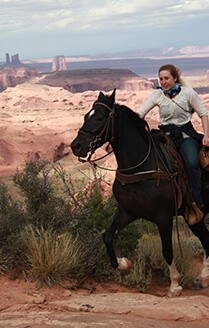
The Fox Trot is a broken trot. However, a broken trot is not necessarily a Fox Trot. The Fox Trot is a diagonal 4-beat gait. The Fox Trot is a stylish gait where the horse walks in an elegant manner with the front legs, and trots with the hind legs. The front hoof hits the ground a split-second before the diagonal rear hoof. There is no fly time as seen in a conventional 2-beat diagonal trot. There is always one front hoof on the ground and there is always one rear hoof on the ground. Each front (or rear) hoof is not picked up until the other front (or rear) hoof is set down. With a correct Fox Trot the horse always has at least 2 or 3 hooves on the ground. The result is a comfortable smooth ride for the rider and an efficient low-fatigue gait for the horse.
This rhythmic motion travels through the whole body from nose to tail. The head should be slightly elevated and nods in unison with the rhythm of the rear feet. The front legs should not show any high knee action and each front hoof hits the ground a split-second before the diagonal rear hoof. The hind legs should perform a sliding movement, during which the hind hoof steps into or over the track of the front hoof. The tail is to be carried in a naturally elevated manner and should also move in rhythm with the gait. The gait should be flat, in correct rhythm and must be consistent over distance.
see videoThe Flat Foot Walk is an even 4-beat gait in lateral step sequence. The track of the hind hoof should over stride the track of the front hoof. When executed correctly, one can hear the steady equal four beat cadence of the hooves. The up and down motion of the head in the walk is stronger than during a Fox Trot. The gait should be flat and consistent over distance.
see videoThe Canter is a rhythmic 3-beat semi-collected gait. The definition “Canter” and “Lope” are inter-changeable. The Canter of the Fox Trotter should be rhythmic, and able to cover ground at moderate speed. It is similar to the lope of a Western Horse and should have a slightly rolling motion. The horse should appear relaxed and move freely on a light rein.
see videoThe Show Canter is required during performance classes in the USA beginning with Open 4-year old horse Performance classes and Amateur 5-year old horse Performance classes. In Europe the Show Canter generally begins with 6-year old horse Performance classes. The Show Canter is a rhythmic three beat gait and shall be performed in a straight, collected manner with the head and tail slightly elevated. The horse shall travel with a forward rolling motion while on the correct lead. The 3-beat gait is performed with a rocking chair motion and starts with the outside rear foot, then to the inside rear-outside front combination, and then to the inside front foot. The head should be at its lowest point when the inside front foot is on the ground. The Show Canter is not a fast-moving gait, and the horse should appear relaxed and move freely. Too much elevation in front, failure to maintain forward motion, four beat canter and/or excessive speed and excessive pumping with the reins are not appropriate.
see video

In 1821 the first settlers crossed the Mississippi River and settled in the Ozark Mountains in Missouri. Most of them came from Tennessee, Illinois, Kentucky, Virginia and Arkansas. They brought their riding horses with them. The settlers in the rough Ozarks needed horses that were easy to ride, could handle steep ascents well, and could cover long distances safely, fast and with good endurance. The Missouri Fox Trotter’s characteristic gait was favored in the difficult terrain. The settlers began to breed horses with a ” broken stride “, now known as the Foxtrot.
The Fox Trot gave its name to the breed and became characteristic of it. Fox Trotter horses have a natural tendency for the broken trot (a four-beat gait). The Missouri Fox Trotter is a flat-footed horse and therefore is very sure-footed and safe. Due to the flat and broken gait the rider feels hardly any movement and sits comfortably in the saddle even after long durations of time.
The bloodlines of the Missouri Fox Trotter go back to the early ranches, farms and the working horses of the early settlers. In this early time there were no associations, stud books or registrations. The Alsup family settled in the Ozarks before the civil war and brought with them a stallion called “Bremmer”. This stallion also produced horses that were very successful on the racetrack and made a lot of money for their owners.



Other bloodlines of today’s Missouri Fox Trotter can be traced back to “Old Fox” who was born around 1921. “Old Fox” died 1936 from pneumonia.
In 1948 the Breeding Association for Missouri Fox Trotter was founded. The purpose was to preserve the Missouri Fox Trotters’ assets for the future development of the breed. All horses that applied to be included in the registration had to show the Fox Trot. In the early days the bloodlines of a large percentage of the registered horses could be traced back to the Saddlebreds. Later, especially when tournaments began in the 1960s and 1970s, more and more Tennessee Walking Horses (TWHs) were bred in. Today the modern Missouri Fox Trotter is more refined, more elegant and considerably faster in the Walk as well as in the Fox Trot. Its legendary surefootedness, endurance, calmness and its sociable character of “Old Fox” have been preserved.
